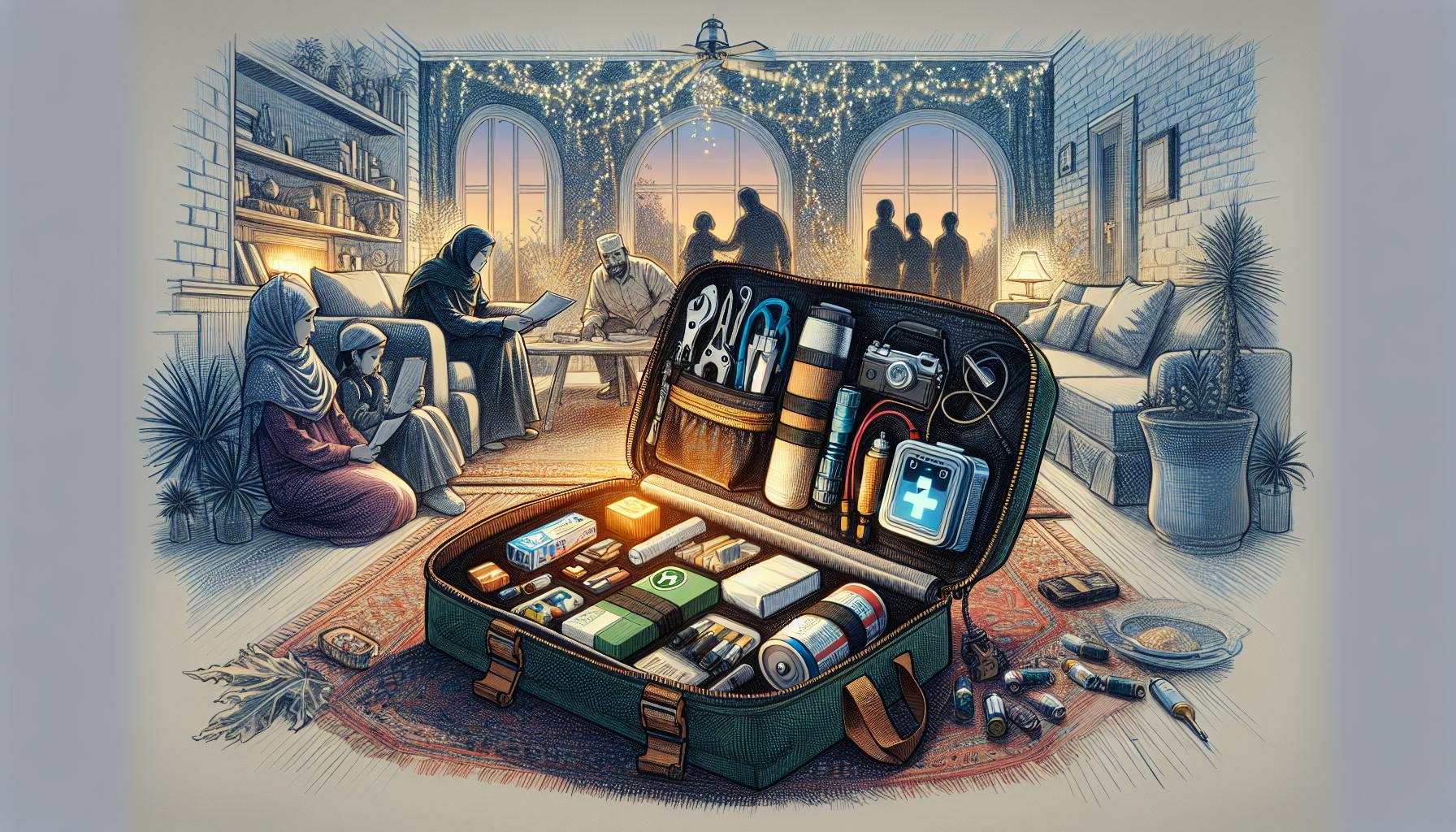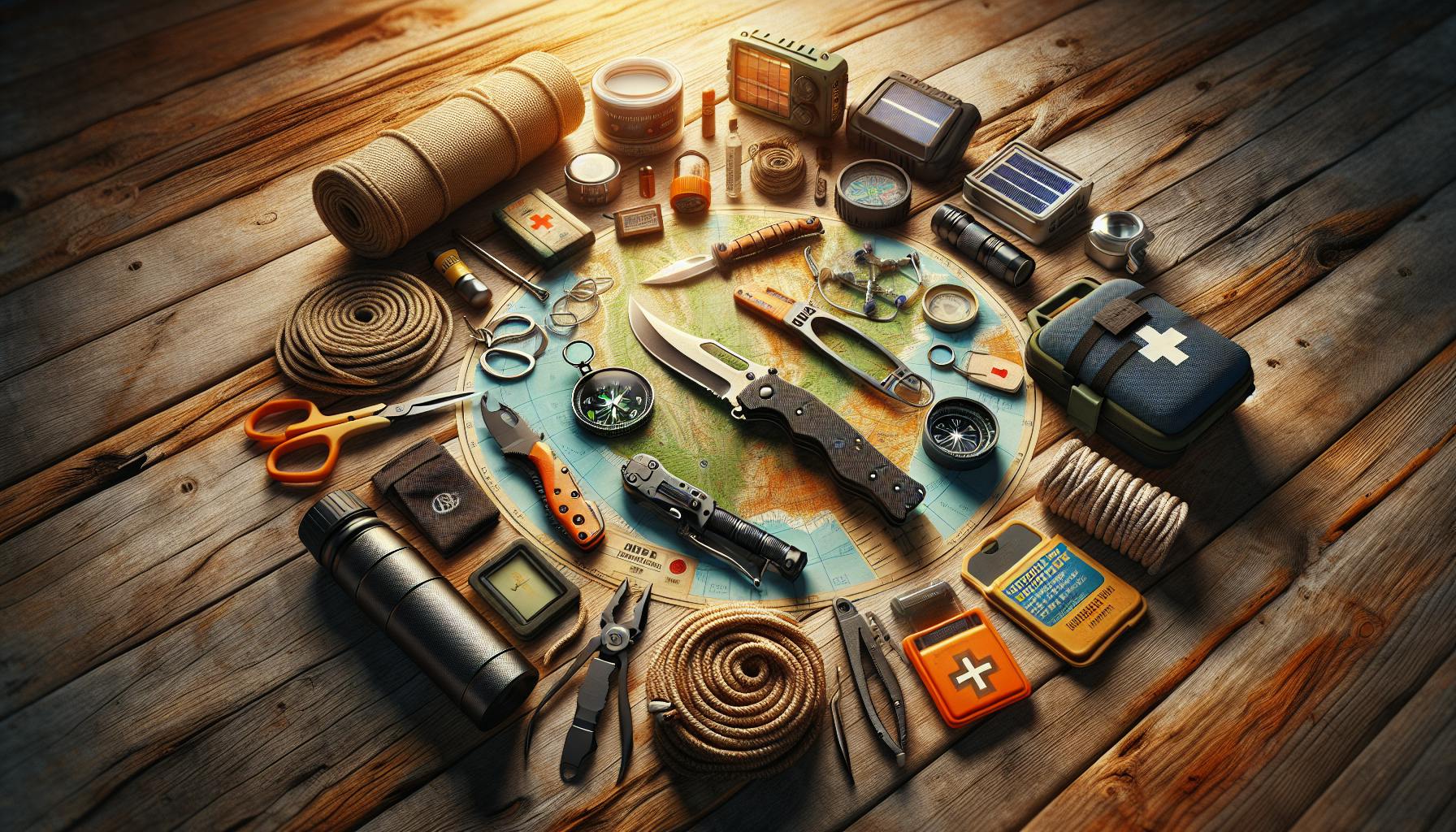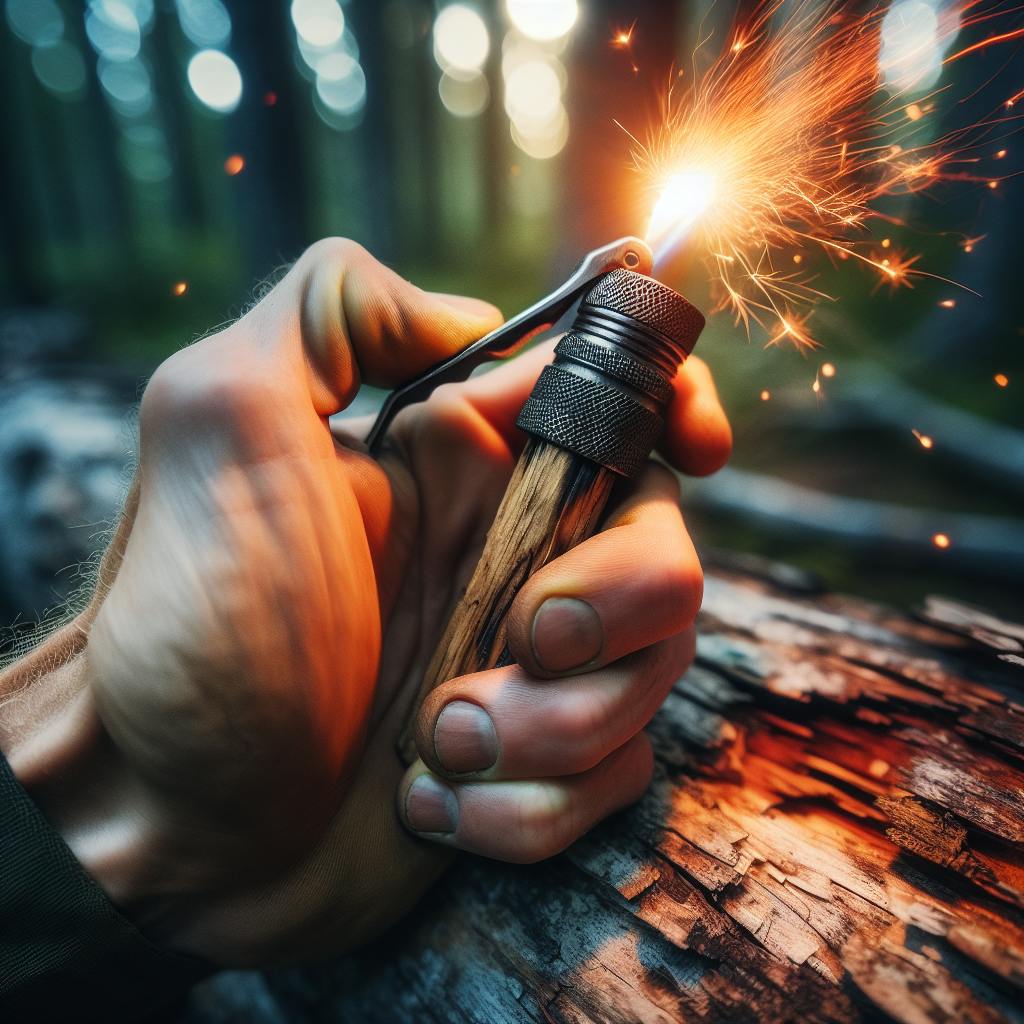When starting out in prepping, it's easy to feel overwhelmed by all the information and products targeted at "preppers."
This article will cut through the confusion to provide beginner preppers with an essential gear checklist focused on the fundamentals for emergency preparedness, sustainability, and self-reliance.
You'll discover the critical categories of gear that every new prepper needs, from water storage to medical kits. You'll also get useful tips for building your capabilities on a budget with DIY solutions.
Introduction to Prepping Essentials for Beginners
Getting started with prepping can be overwhelming, but having the right essential gear makes the process simpler. As a beginner, focus first on versatile items that cover basic needs like water, food, first aid, shelter, and navigation.
Specialized tools can come later. Build your skills and knowledge first with these fundamental prepping essentials.
What is Prepping
Prepping refers to making active preparations for emergencies or disasters by gathering necessary supplies and gear. It promotes self-reliance in case access to utilities, transport or stores is disrupted.
Being prepared with reliable gear not only reduces panic, but can save lives during crises. Prepping equips people to handle both natural disasters like storms, earthquakes or floods, as well as manmade events like technological disruptions or civil unrest.
Why Prepare
Emergencies can strike suddenly, so being prepared ahead of time is wise. Having reliable supplies on hand reduces panic, instills confidence to act, and allows one to help others.
Self-reliance is empowering. Not having to scramble for critical items during a crisis allows people to focus energy on coordination, communication and recovery efforts.
Being prepared also mitigates the impact of disasters. Having medical supplies allows prompt response to injuries, stored water prevents dehydration, while emergency food sustains people until utilities are restored.
Beginner Prepping Principles
When getting started, resist the temptation to buy specialized tools. Focus first on versatile essentials that cover basic needs:
Water - Store and filter water to prevent dehydration
Food - Stock non-perishable nutrition to avoid hunger
First Aid - Prepare to treat injuries until help arrives
Light - Carry flashlights and lamps for navigation when dark
Shelter - Pack tarps, blankets and bivvy bags to stay warm and dry
Buy durable, reliable items that are easy to transport and use. As you gain experience, add supplemental items to round out your capability.
Critical Prepper Gear Categories
This section will break down the key types of gear that every new prepper should have on hand, including tools for survival, self-defense, communication, medical care, and more. Having the right equipment and supplies is crucial for emergency preparedness.
Water Storage and Purification Essentials
When building your stockpile list items for survival, one of the most critical categories is water solutions. Every prepper should have multiple ways to store and purify water in case of emergency. Some recommended items include:
- Collapsible water containers and water barrels for water storage
- Water purification systems like the Sawyer Mini or Lifestraw to ensure access to clean water
- Water filtration devices such as gravity filters or pump filters
- Water purification tablets as a lightweight backup option
Storing at least 1 gallon of water per person per day is a common benchmark. Having both short-term and long-term water storage is ideal for flexibility.
Food Storage Solutions and Non-Perishable Supplies
In addition to water, non-perishable food is essential when preppers stock up for disasters. Some key strategies include:
- Stockpile freeze-dried foods in #10 cans or Mylar bags
- Store rice, beans, pasta, oats, wheat, and other staples in food-grade buckets
- Take inventory of your pantry and rotate supplies as needed
- Grow your own fruits, vegetables, and herbs
Canned goods, boxed goods, honey, salt, spices, and more help round out your reserves. Calculate at least a 3-month supply when possible.
Survival Clothing and Shelter Options
From extreme weather to hazardous environmental conditions, having the right survival clothing and shelter is vital. Consider adding:
- Insulated jackets, waterproof outerwear, moisture-wicking base layers
- Emergency tarps for makeshift shelters and covering supplies
- Tents, sleeping bags, and sleeping pads for portable housing
- Wool socks, gloves, hats, scarves, and gaiters to protect extremities
Choose versatile, durable fabrics suited for your climate and likely risks.
Self-Defense Equipment and Training
While not always top of mind, self-defense tools and skills are prudent precautions for preppers to take. Gear and training may include:
- Firearms and ammunition for security and hunting
- Non-lethal weapons like pepper spray and stun guns
- Hand-to-hand combat skills through martial arts, boxing, etc.
- Situational awareness and de-escalation techniques
- Two-way radios for communication
Take appropriate courses and practice routinely with any equipment. Vet local laws.
Medical Kits and Health Supplies
From a basic first aid kit to a trauma-equipped bug out bag, having medical gear on hand is non-negotiable:
- Bandages, gauze, tape, tourniquets, shears, gloves, blankets
- Medications, antibiotics, pain relievers, topical treatments
- Sutures, surgical tools, chest seals, decompression needles
- Blood pressure cuffs, stethoscopes, thermometers, pulse oximeters
Store supplies suited to your skills and rotate items before expiration.
Communication and Information Tools
Reliable news and connectivity are invaluable when disasters strike. Emergency radios, maps, two-way radios, and satellite phones help you stay informed, navigate risks, and communicate with others. Key items include:
- Crank or solar-powered radios to receive broadcast alerts
- Detailed local maps for navigation if GPS fails
- Two-way radios for short-range walkie-talkie communication
- Satellite phones and messaging devices as backup options
Don't overlook old-school options like compasses and paper maps either.
Essential Prepper Gear Checklists
This section provides recommendations on key survival and prepping gear to have on-hand for different scenarios.
The Ultimate Bug Out Bag Essentials
A bug out bag contains supplies needed to evacuate quickly during an emergency. Here are 25 must-have items to include:
- Navigation items (map, compass, GPS device)
- First aid kit
- Multi-tool
- Fire starting equipment (matches, lighter, fire starters)
- Shelter supplies (emergency blanket, tarp, cordage)
- Light sources (flashlight, headlamp, glow sticks)
- Food rations and water filtration/purification tools
- Communication devices (emergency radio, cell phone, chargers)
- Self-defense items (pepper spray, knife, whistle)
- Hygiene products (toothbrush, soap, feminine products)
- Extra clothing and footwear
- Cash in small denominations
- Local maps
- Duct tape
- Work gloves
- Emergency sleeping bag
- Rain poncho
- Rope/paracord
- Fishing line and hooks
- Space blanket
- Mirror for signaling
- Notebook and pen for leaving notes
- Garbage bags for waste
Having these fundamental supplies on-hand ensures you can effectively evacuate during a crisis. Tailor items to your personal needs.
Get Home Bag Must-Haves
A get home bag prepares you to travel safely when away from home during an emergency. Vital items include:
- Sturdy shoes/boots
- Multiple light sources (flashlight, glow sticks)
- First aid supplies
- Knife or multi-tool
- Easy-to-carry food rations
- Water and water purification method
- Weather-appropriate clothes
- Local map with alternate routes home
- Cash in small bills
- Emergency space blanket
- Fire starting items (matches, lighter)
- Protective work gloves
- Duct tape
- Compass
- Personal hygiene items
- Chargers for electronic devices
- Paper, pen, permanent marker
With these basics covered, you can traverse difficult conditions to return home.
Everyday Carry (EDC) Prepper Gear
An EDC kit prepares you for everyday uncertainties. Great options include:
- Multi-tool (pliers, knife, screwdrivers)
- Flashlight
- Lighter
- First aid supplies
- Heavy-duty emergency blanket
- Pepper spray
- Cash in small denominations
- Pen and paper
- Whistle for signaling
- Compass
- Paracord or rope
- Water purification tablets
- Space blanket
- Snack bars
Choose compact items that seamlessly fit your lifestyle. Streamline based on personal routines.
Comprehensive Stockpile List for Long-Term Survival
For extended emergencies, stockpile:
Water - Store 1+ gallon per person daily. Have water filtration/purification supplies.
Long-shelf-life Food - Stockpile non-perishables like rice, beans, canned goods, honey, salt, etc. Consider freeze-dried meals.
Fuel and Power - Stockpile propane, fuel stabilizer, generator, solar charger.
Sanitation and Hygiene - Stock soaps, disinfectant, toilet paper, feminine products, etc.
Lighting - Have multiple flashlights, lanterns, glow sticks, solar lights.
Communication - Emergency radio, walkie talkies, signal whistle.
Tools - Axes, shovels, saws for shelter/firewood. Pliers, wrench for repairs. Sewing kit.
First Aid - Extensive trauma kit. Medications, bandages, ointments.
Clothing and Bedding - Season-appropriate clothes, boots, hats, gloves. Blankets, sleeping bags.
Money - Cash in small bills. Barter items like liquor, cigarettes.
Defense/Hunting - Knives, pepper spray, firearms (if desired and legally owned). Fishing line/hooks, snares.
Adjust quantities based on household size and length of emergencies you are prepping for.
sbb-itb-b932644
Prepping on a Budget: DIY Gear and Affordable Finds
Learn how to create your own DIY prepper gear and discover budget-friendly items that don't compromise on quality.
DIY Water Filters and Purification Methods
Water purification is essential for survival. Store-bought water filters can be expensive, but you can make your own using basic household items.
Here are some budget-friendly DIY methods to purify water:
- A sand filter made from bottles, sand, gravel and cloth can remove parasites and debris.
- Boiling water for 1 minute kills most bacteria, viruses and parasites.
- Use 8 drops of plain, unscented bleach per gallon to kill germs. Double the bleach if the water is cloudy or cold.
Test your water's purity with pool test strips after filtering or purifying. Having clean drinking water is vital in an emergency.
Home-Made Food Preservation Techniques
Stockpiling food is great, but it won't last forever. Try these cheap preservation methods:
- Dehydrate fruits and veggies using a basic dehydrator, oven or even the sun. Vacuum seal for long-term storage.
- Can foods like meat, veggies and sauces using mason jars and a pressure canner.
- Freeze food in vacuum-sealed bags to prevent freezer burn.
Properly stored home-preserved foods can last for years. You'll save money by buying in bulk when items are on sale.
Creating Your Own Emergency Lighting Solutions
Don't be left in the dark during a power outage. Make these easy DIY lighting options:
- Turn a mason jar into a solar-powered lamp using scrap wood, a solar garden light and glue.
- Make oil lamp wicks from cotton balls and vegetable oil in jars or cans with lid holes.
- Use glow sticks and reflectors to amplify portable light sources.
Having multiple hands-free lighting options is vital when the power goes out.
Building a Personal Faraday Cage
A Faraday cage blocks electromagnetic pulses that can fry electronics. Build one cheaply using:
- A metal trash can or ammo box lined with cardboard.
- Aluminum foil wrapped around devices inside non-conductive containers.
- Metal mesh like chicken wire shaped into a box.
Store radios, batteries, phones and other essential electronics inside to protect them from EMPs.
Handcrafted Tools and Survival Gear
Get crafty and make practical survival items from materials around your home:
- Braid paracord into bracelets, belts, straps and tie-downs.
- Craft hunting/fishing spears using knife blades, poles and duct tape.
- Make tinder with dryer lint, wax and egg cartons for fire starting.
- Use PVC pipe to build shelters and store caches.
With some creativity, you can be prepared on any budget. Focus on necessities first, then upgrade gear over time.
Advanced Prepping Gear for Enhanced Readiness
This section delves into more sophisticated gear that can offer additional comfort, convenience, and security for preppers ready to take their preparedness to the next level.
Electric Coolers and Portable Generators
Electric coolers provide reliable temperature control to keep food fresh longer during power outages. Models with solar panels can run indefinitely without fuel. Portable generators offer resilient backup power for lighting, appliances and device charging. Quiet solar generators have minimal noise/fumes. When selecting models, consider output wattage, fuel type, runtime and noise level based on your needs.
Climate Control: Heaters and Fans for Off-Grid Living
Maintaining comfortable temperatures is key for health and morale during extended off-grid scenarios. Portable propane and kerosene heaters offer safe supplemental heat. Battery or solar-powered fans provide quiet cooling without fuel. For vehicle/temporary shelter use, 12V powered models connect to car outlets. When choosing, prioritize safety features, battery life/solar efficiency, temperature control range and noise.
Enhanced Security with Solar Security Lights
Strategically placed solar security lights deter unwanted access and provide hands-free visibility around the perimeter during nighttime emergencies. Models with motion sensors automatically activate when threats approach. Select durable, weatherproof lights with adjustable sensor range, brightness settings, and wide solar charging efficiency for reliable operation.
Vehicle Preparedness: Repair Tools and Emergency Kits
A well-stocked vehicle repair kit and emergency supplies can make the difference between safe passage and being stranded in a disaster scenario. Essentials include jumper cables, jack/lug wrench, tow strap/rope, fix-a-flat, duct tape, work gloves, road flares, flashlight, first aid supplies, non-perishable food, water, blankets. Durable bags keep gear organized for rapid response.
Unique Prepper Items for Specialized Situations
- Faraday bags and cages shield electronics from damaging EMPs.
- Two-way radios enable communication if cell networks fail.
- Local maps allow navigation without cell signal.
- Fishing/hunting tools provide food sources.
- Bartering items (batteries, lighters, alcohol, cigarettes) hold value for procuring needed supplies.
- Water filters/chemical treatment tackle contaminated water.
- Gas masks offer protection from airborne hazards.
Researching specialized threats you may face will determine optimal items for your situation. An edge in specific scenarios can make the difference.
Conclusion
Prepping provides peace of mind and improves chances of survival when disaster strikes. Start simple with versatile gear for water, food, first aid, shelter, and self-defense, and gradually build up to more advanced equipment as your skills and needs evolve.
Recap of Beginner Prepping Basics
When first getting started with prepping, focus on investing in highly versatile items that meet essential survival needs:
-
Water - Store water or have purification methods like filters or chemical treatments. Have sealed containers and access to water sources.
-
Food - Stockpile non-perishable foods with long shelf lives. Consider freeze-dried foods. Store foods properly using mylar bags and oxygen absorbers.
-
First Aid - Have first aid kits and trauma supplies to treat injuries. Know basic medical skills, CPR, wound care.
-
Shelter - Have emergency blankets, tents, tarps for temporary shelter. Prepare your home to withstand disasters.
-
Self-Defense - Be able to defend yourself with appropriate weapons and ammunition for your situation.
As a beginner, focus investments in these key categories first before specialized prepping gear.
Importance of Developing Self-Reliance
Recent disasters have shown just how quickly critical infrastructure can fail, underscoring the need for individual and community self-reliance. Rather than depending on fragile systems, prepping encourages:
- Localized food production
- Decentralized energy such as solar
- Rainwater collection
- Bartering within communities
- Shared knowledge and skills
Relying solely on centralized systems leaves people vulnerable. Preparing makes households more resilient when those systems inevitably fail.


